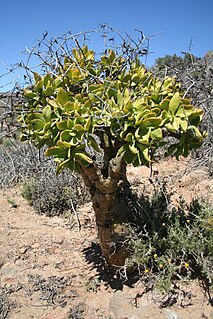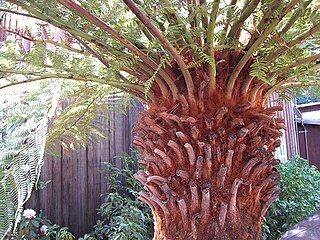
Caltha palustris, known as marsh-marigold and kingcup, is a small to medium size perennial herbaceous plant of the buttercup family, native to marshes, fens, ditches and wet woodland in temperate regions of the Northern Hemisphere. It flowers between April and August, dependent on altitude and latitude, but occasional flowers may occur at other times.

Cotyledon is a genus of succulent plants in the Crassulaceae family. Mostly from Southern Africa, they also occur throughout the drier parts of Africa as far north as the Arabian peninsula.
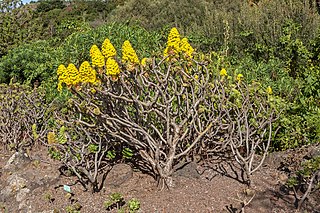
Aeonium arboreum, the tree aeonium, tree houseleek, or Irish rose, is a succulent, subtropical subshrub in the flowering plant family Crassulaceae. It is native to the hillsides of the Canary Islands, where it is known as bejeque arboreo and introduced in the Mediterranean It bears rosettes of leaves and large pyramidal panicles of bright yellow flowers in the spring. In temperate regions it needs to be grown under glass. The purple cultivar 'Zwartkop' ('Schwartzkopf') has gained the Royal Horticultural Society's Award of Garden Merit. and a variegated form is grown as cultivar 'variegatum'.

Epiphyllum crenatum, the crenate orchid cactus, is a species of cactus and one of the most important parents in creating the Epiphyllum-hybrids commonly cultivated throughout the world. It is cultivated for its beautiful diurnal flowers.

Cotyledon orbiculata, commonly known as pig's ear or round-leafed navel-wort, is a South African succulent plant belonging to the genus Cotyledon.
Tylecodon aridimontanus is a species of plant in the Crassulaceae family. It is endemic to Namibia. Its natural habitat is rocky areas. It is threatened by habitat loss.
Tylecodon aurusbergensis is a species of plant in the Crassulaceae family. It is endemic to Namibia. Its natural habitat is rocky areas. It is threatened by habitat loss.

Polygonatum odoratum syn. P. officinale, is a species of flowering plant in the family Asparagaceae, native to Europe, the Caucasus, Siberia, the Russian Far East, China, Mongolia, Korea and Japan. In the United Kingdom it is one of three native species of the genus, the others being P. multiflorum and P. verticillatum.
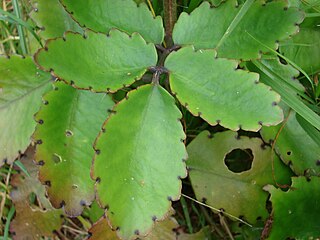
Bryophyllum pinnatum, also known as the air plant, cathedral bells, life plant, miracle leaf, and Goethe plant is a succulent plant native to Madagascar, which is a popular houseplant and has become naturalized in tropical and subtropical areas. It is distinctive for the profusion of miniature plantlets that form on the margins of its phylloclades, a trait it has in common with some other members of its genus.

Erigeron philadelphicus, the Philadelphia fleabane, is a widespread North American plant in the daisy family. Also known as common fleabane, daisy fleabane, frost-root, marsh fleabane, poor robin's plantain, skervish, and in the British Isles as robin's-plantain. It is native to North America and found there in nearly all of the United States and Canada. It is also introduced into Europe and Asia, considered an invasive weed in many places.

Aeonium haworthii is a species of succulent flowering plant in the family Crassulaceae. It is native to the Canary Islands, but it has been introduced to other areas of similar climate, such as Southern California. It is a sand-dwelling beach plant, a subshrub with rough, woody stems and rosettes of thick, red-edged green leaves which are triangular or diamond- or spade-shaped. It grows to 60 cm, with panicles of cream-colored pointed flowers produced in spring.

Sinocrassula is a genus of succulent, subtropical plants of the family Crassulaceae.

Echeveria setosa, the Mexican fire cracker, is a species of flowering plant in the family Crassulaceae, native to semi-desert areas of Mexico and common throughout Puebla.

Cyclamen persicum, the Persian cyclamen, is a species of flowering herbaceous perennial plant growing from a tuber, native to rocky hillsides, shrubland, and woodland up to 1,200 m (3,900 ft) above sea level, from south-central Turkey to Lebanon-Syria and the Palestine region. It also grows in Algeria and Tunisia and on the Greek islands of Rhodes, Karpathos, and Crete, where it may have been introduced by monks. Cultivars of this species are the commonly seen florist's cyclamen.

Crassula muscosa, synonyms Crassula lycopodioides and Crassula pseudolycopodioides, is a succulent plant native to South Africa and Namibia, belonging to the family of Crassulaceae and to the genus Crassula. It is a houseplant grown worldwide and commonly known as rattail crassula, watch chain, lizard's tail, zipper plant and princess pine.
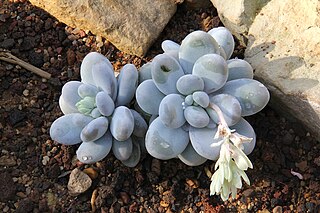
Pachyphytum oviferum is a species of plant in the genus Pachyphytum . The meaning of the name Pachyphytum oviferum is thick plant bearing eggs.
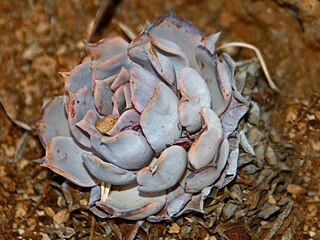
Echeveria lilacina, common name Ghost Echeveria or Mexican Hens and Chicks, is a species of succulents in the genus Echeveria belonging to the family Crassulaceae. The genus name Echeveria was given in honor of the 18th century Mexican botanist and painter Atanasio Echeverría y Godoy, famous for his paintings of plants.

Sedum palmeri is a stonecrop originated from Mexico with persistent light green leaves, becoming marked in red during winter.
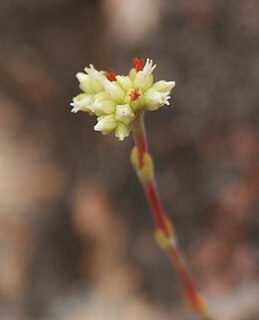
Crassula atropurpurea is a succulent plant, very common and widespread in the southern Karoo regions of South Africa and Namibia.


